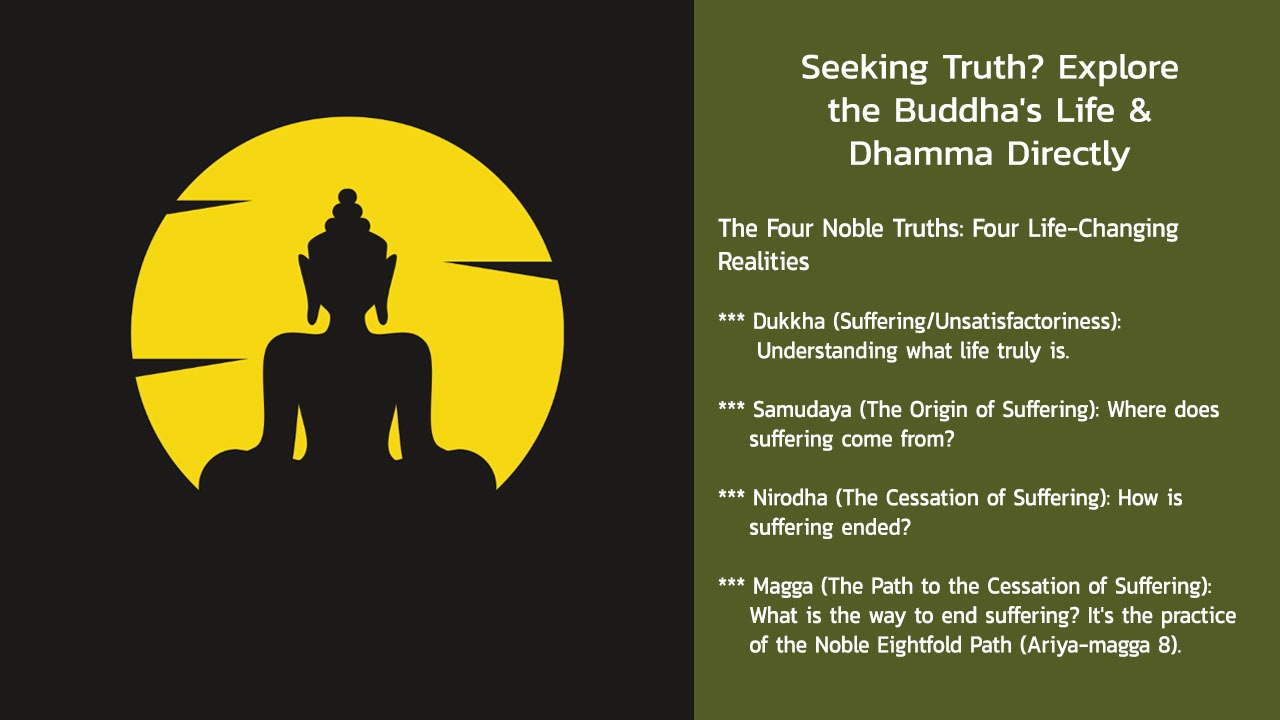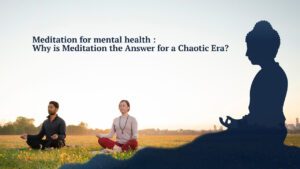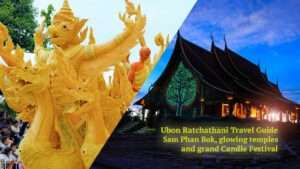The Buddha’s Story, Made Easy: Straight from His Own Words (Buddhavaćana)

Want to understand Buddha’s enlightenment directly? Discover the authentic teachings (Buddhavaćana) straight from his own words, without added interpretations. Get to the core of Buddhism, simply and clearly.
Siddhartha: The Prince Who Chose a New Path
Before achieving Buddha’s enlightenment and becoming the great Buddha, he was known as Prince Siddhartha (meaning “He Who Achieves His Aim”). He was born into the Sakya clan in Lumbini Garden. Despite a life of luxury in the palace, one thing troubled the Prince deeply: the suffering he saw people endure. This included birth, old age, sickness, death, sorrow, lamentation, physical pain, mental distress, and despair.
Upon realizing the world was full of suffering, Prince Siddhartha made a monumental decision. He left his comfortable life behind to become an ascetic, seeking ultimate truth (saccadhamma) that would lead to liberation from all suffering.
P.S. Siddhartha is a name that appears in the commentaries (atthakatha), which are later additions. In the earliest scriptures (the Buddhavaćana itself), the Buddha is primarily referred to as Gotama.
The Search and Buddha’s Enlightenment : A Turning Point for the World
After renouncing the world, Prince Siddhartha intensely practiced various spiritual disciplines. However, he couldn’t find the true path to freedom from suffering. Finally, he committed to self-practice under the Bodhi tree on the banks of the Neranjara River. During the night of his enlightenment, he attained three crucial knowledges (ñāna):
- Pubbenivasanussati-ñāna: The knowledge of remembering past lives.
- Cutupapata-ñāna: The knowledge of the passing away and reappearance of beings according to their karma.
- And most importantly, the realization of the Four Noble Truths (Ariya-sacca 4), which are the noble truths that lead to complete freedom from all suffering! This is how he earned the title Sammāsambuddha (the Perfectly Self-Enlightened One).
After his enlightenment, the Buddha began to teach the Dhamma to sentient beings. He delivered his first sermon, the Dhammacakkappavattana Sutta, to the Pañcavaggiya (the group of five ascetics) in the Deer Park at Isipatana, Sarnath. He spread the teachings of Buddhism for 45 years before passing into Parinibbana (final Nibbana) in Kusinara.

The Core of Buddhavaćana: Easy to Understand, Practical to Apply
The heart of Buddhavaćana is its focus on the precise teachings spoken by the Buddha himself, as found primarily in the Sutta Piṭaka section of the Tripitaka. Specifically, the Four Noble Truths and the Noble Eightfold Path are the true roadmap to freedom from suffering.
1. The Four Noble Truths: Four Life-Changing Realities
These are the core of Buddhism, discovered and taught by the Buddha as his first discourse. They are like a diagnosis of an illness and its cure:
- Dukkha (Suffering/Unsatisfactoriness): Understanding what life truly is. It’s physical and mental discomfort, birth, old age, sickness, death, sorrow, lamentation, separation from loved ones, association with what is disliked, and in short, the five aggregates of clinging (upādānakkhandha) – form, feeling, perception, mental formations, and consciousness – are suffering.
- Samudaya (The Origin of Suffering): Where does suffering come from? It arises from Taṇhā (craving) in three forms: craving for sensual pleasures (kāmataṇhā), craving for existence (bhavataṇhā), and craving for non-existence (vibhavataṇhā).
- Nirodha (The Cessation of Suffering): How is suffering ended? It’s the complete eradication of craving, the letting go of all desires, and the five aggregates of clinging.
- Magga (The Path to the Cessation of Suffering): What is the way to end suffering? It’s the practice of the Noble Eightfold Path (Ariya-magga 8).
2. The Noble Eightfold Path: The Middle Way to Peace
This is the practical guide to achieving complete cessation of suffering. It’s the middle way, avoiding extremes of sensual indulgence or self-mortification:
- Sammā-diṭṭhi (Right View): Understanding the Four Noble Truths, the Three Characteristics of Existence, and karma with its results.
- Sammā-saṅkappa (Right Intention/Thought): Thoughts free from sensual desire, ill-will, and harm.
- Sammā-vācā (Right Speech): Abstaining from false speech, divisive speech, harsh speech, and idle chatter.
- Sammā-kammanta (Right Action): Abstaining from taking life, stealing, and sexual misconduct.
- Sammā-ājīva (Right Livelihood): Earning a living in a way that doesn’t harm oneself or others.
- Sammā-vāyāma (Right Effort): Striving to prevent unwholesome states from arising, abandoning unwholesome states that have arisen, cultivating wholesome states, and maintaining wholesome states that have arisen.
- Sammā-sati (Right Mindfulness): Being mindful of the body, feelings, mind, and mental objects (the Four Foundations of Mindfulness).
- Sammā-samādhi (Right Concentration): Developing a focused and unwavering mind (especially through the practice of Anapanasati).

3. Tilakkhaṇa (Three Characteristics of Existence): Understanding the Nature of the World
These are the fundamental truths about all phenomena in the world, helping us release attachment:
- Anicca (Impermanence): Everything arises, exists for a time, and then ceases. Nothing is permanent or stable.
- Dukkha (Suffering/Unsatisfactoriness): Everything is subject to change, decay, and is ultimately unsatisfactory or difficult to endure.
- Anattā (Non-self): Nothing is a true, enduring self or soul. There is no inherent essence or owner; things cannot be controlled according to one’s desires.
4. Paṭicca-samuppāda (Dependent Origination): The Cycle of Suffering and Liberation
This principle explains how suffering arises and ceases in an interconnected chain. It helps us understand the cycle of rebirth (saṃsāra) and the path to freedom from it. For example: “With ignorance as condition, volitional formations arise; with volitional formations as condition, consciousness arises…” leading to “Thus is the arising of this whole mass of suffering.” And when the conditions cease, the results also cease.
5. Anapanasati (Mindfulness of Breathing): Being Present with Your Breath
This is a meditation practice the Buddha emphasized and used himself for enlightenment, serving as a noble abiding (vihāra-dhamma). Practicing Anapanasati involves being aware of the in-breath and out-breath, observing the states of body, feelings, mind, and mental objects that arise with each breath. This leads to the development of wisdom and liberation (vimutti).
Studying Buddhavaćana means directly engaging with the Buddha’s authentic teachings, revealing the profound path that led to Buddha’s enlightenment. This empowers practitioners to apply these teachings and experience the results for themselves, without needing interpretations or additions from others, because these are truly “from his own words.
Love this? We’ve got more where that came from — find us at @thaiimpact on X.






